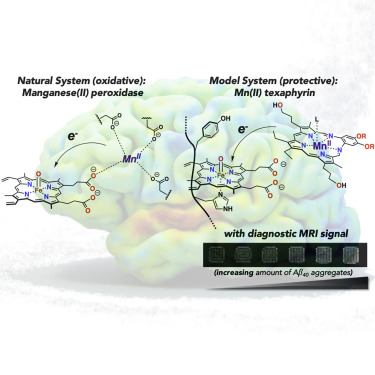Chem ( IF 23.5 ) Pub Date : 2020-01-09 , DOI: 10.1016/j.chempr.2019.12.016 James T. Brewster , Gregory D. Thiabaud , Peter Harvey , Hadiqa Zafar , James F. Reuther , Simone Dell’Acqua , Rachel M. Johnson , Harrison D. Root , Pedro Metola , Alan Jasanoff , Luigi Casella , Jonathan L. Sessler

|
The complex etiology of neurodegeneration continues to stifle efforts to develop effective therapeutics. New agents elucidating key pathways causing neurodegeneration might serve to increase our understanding and potentially lead to improved treatments. Here, we demonstrate that a water-soluble manganese(II) texaphyrin (MMn) is a suitable magnetic resonance imaging (MRI) contrast agent for detecting larger amyloid beta constructs. The imaging potential of MMn was inferred on the basis of in vitro studies and in vivo detection in Alzheimer’s disease C. elegans models via MRI and ICP-MS. In vitro antioxidant- and cellular-based assays provide support for the notion that this porphyrin analog shows promise as a therapeutic agent able to mitigate the oxidative and nitrative toxic effects considered causal in neurodegeneration. The present report marks the first elaboration of an MRI-active metalloantioxidant that confers diagnostic and therapeutic benefit in Alzheimer’s disease models without conjugation of a radioisotope, targeting moiety, or therapeutic payload.
中文翻译:

金属卟啉作为神经退行性疾病的MRI活性催化抗氧化剂:阿尔茨海默氏病研究
神经退行性病的复杂病因继续扼杀开发有效疗法的努力。阐明导致神经退行性病变的关键途径的新药物可能有助于增进我们的了解,并可能导致治疗的改善。在这里,我们证明了水溶性锰(II)texaphyrin(MMn)是用于检测更大的淀粉样β结构的合适的磁共振成像(MRI)造影剂。根据体外研究和通过MRI和ICP-MS在阿尔茨海默氏病秀丽隐杆线虫模型中进行体内检测,推断出MMn的成像潜力。体外基于抗氧化剂和细胞的检测方法支持以下观点:该卟啉类似物显示出有望作为一种治疗剂,能够减轻被认为是神经退行性疾病的氧化和硝化毒性作用。本报告标志着MRI活性金属抗氧化剂的首次开发,该试剂可在不结合放射性同位素,靶向部分或治疗有效载荷的情况下,在阿尔茨海默氏病模型中赋予诊断和治疗益处。


























 京公网安备 11010802027423号
京公网安备 11010802027423号